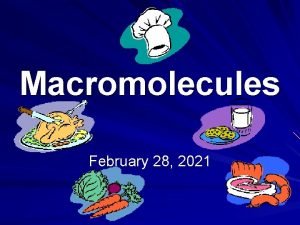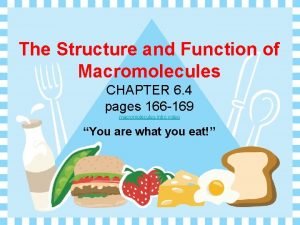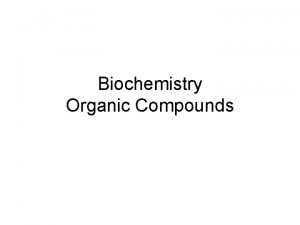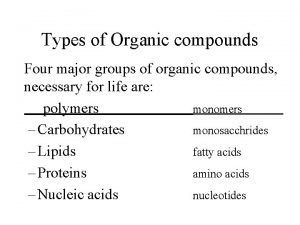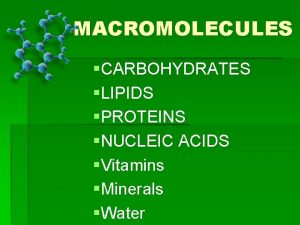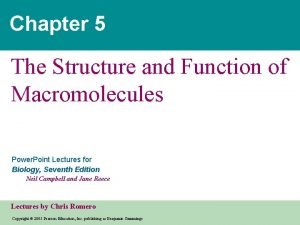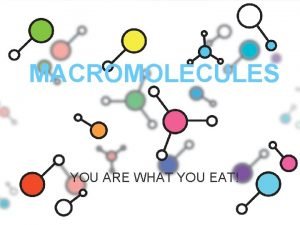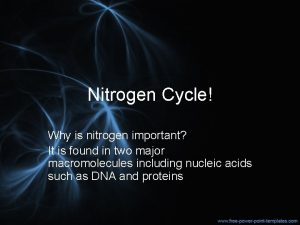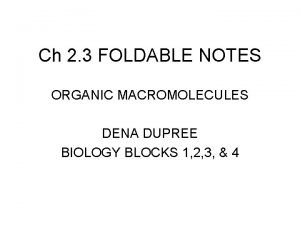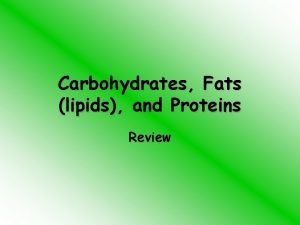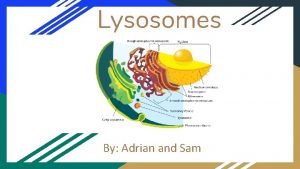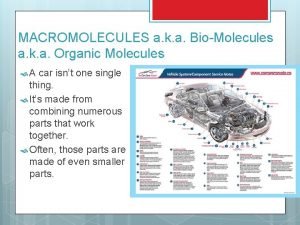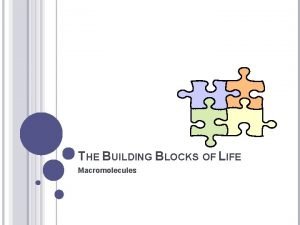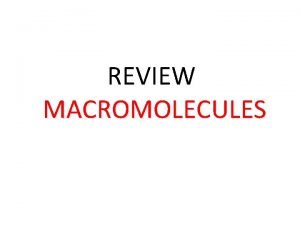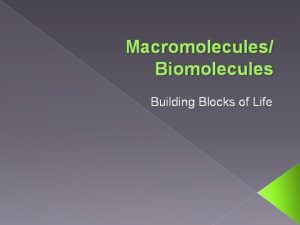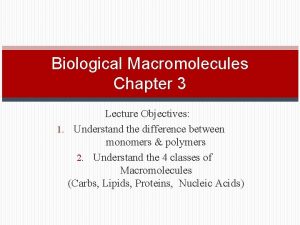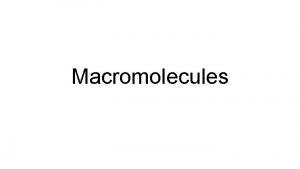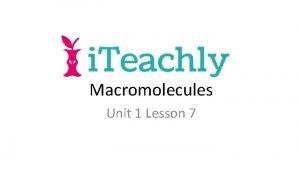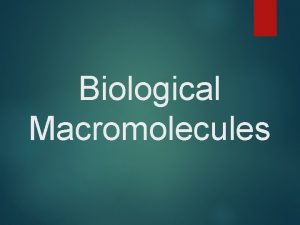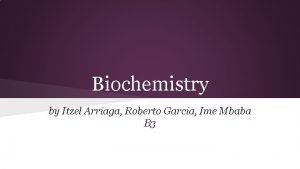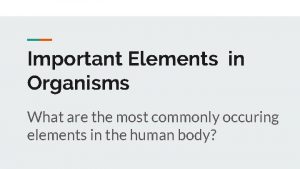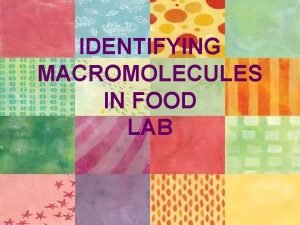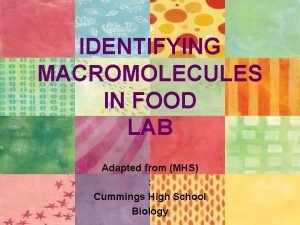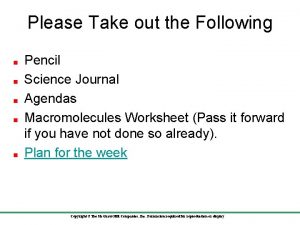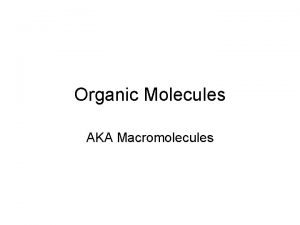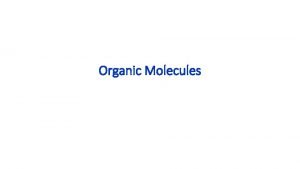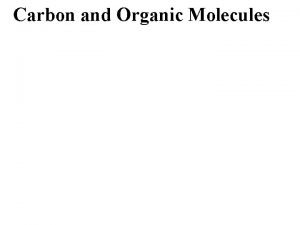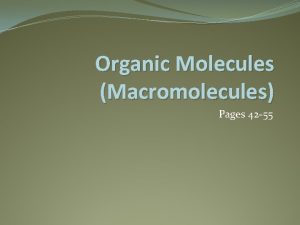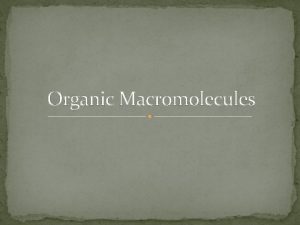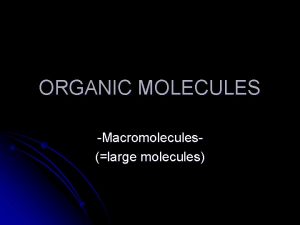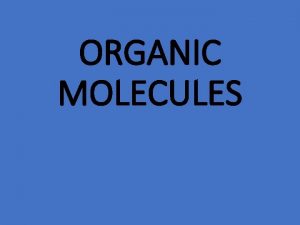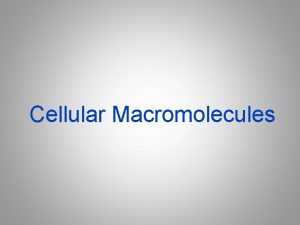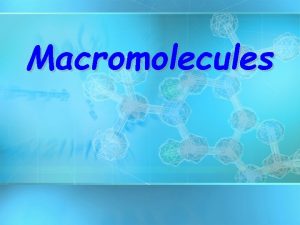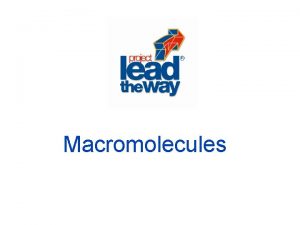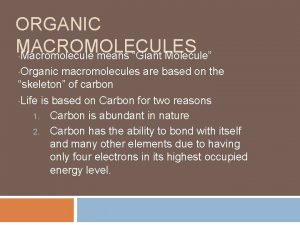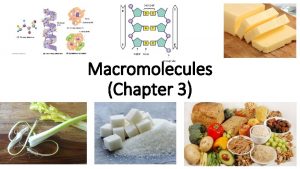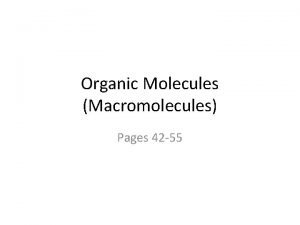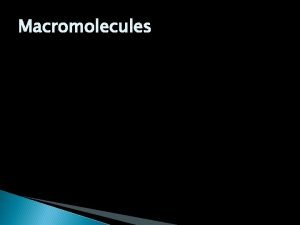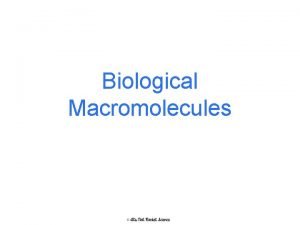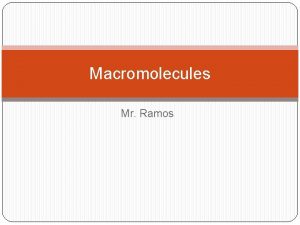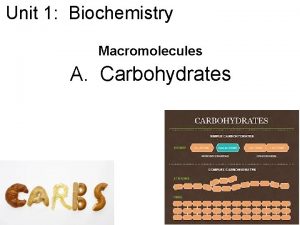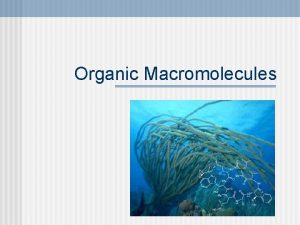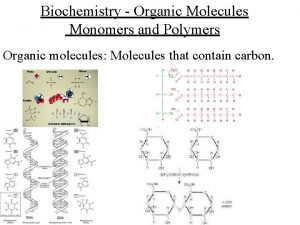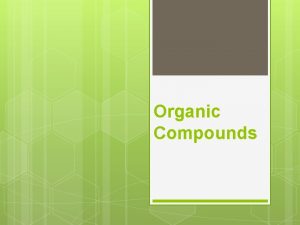1 What are Macromolecules Many organic molecules are



























- Slides: 27

1

What are Macromolecules? • Many organic molecules are so large they are known as Macromolecules which means giant molecules. • We can’t live without them!! – EVERYTHING we will learn for the rest of the semester will be based upon one of these macromolecules 2

Monomers and Polymers Most macromolecules are polymers, built of monomers joined through polymerization. Smaller units called monomers are joined to make polymers through polymerization. • Monomers: small, basic unit (ex. think Brick) – Monomers can be the same or unique • Polymers: complex structure made of monomers (ex. think Brick House) 3

Building Polymers: Dehydration Reaction • To build a polymer, we must link monomers • Building polymers is called a dehydration reaction when monomers unit. – Example: 2 monosaccharides (glucose+ fructose) = 1 disaccharide (sucrose) • Removes a water molecule (gives off water)

Breaking Polymers: Hydrolysis • Breaking polymers is called a hydrolysis reaction • Opposite of Dehydration Reaction • Water is added– water forces its way in and breaks bonds • Breaks big polymers into monomers

Types of Macromolecules: 1. Carbohydrates 1. Lipids 1. Proteins 1. Nucleic Acids 6

Carbohydrates are composed of Carbon, hydrogen and oxygen in a 1: 2: 1 ratio. • Main Function = short-term ENERGY • Other uses = structure/support • Found in: sugar and starch (therefore breads, pastas, fruits and veggies) • Made of: C, H, O in a 1: 2: 1 ratio 7

2 types of Carbohydrates: a. Monomer = Monosaccharides – single sugar molecules – Ex. Glucose (main fuel for cell), Galactose (milk), Fructose (fruit) b. Polymer = Polysaccharides – large molecules formed by monosaccharides. – Ex. Starch (how plants store sugar, grains), Glycogen (how animals store sugar), Cellulose (structural support in plant cell walls) 8

Energy Storage of Carbs • 4 calories/milligram • Because it is short term energy, your body can access it very easily so it is the FIRST thing you will break down to get energy when you need it! 9

Lipids- NON SOLULBLE GROUP OF LARGE AND VARIED MOLECULES MADE OF CARBON AND HYDROGEN AND OXYGEN • Main Function= Long-term Energy Storage • Other uses = cushioning organs, insulation, hormones, cell membrane • Found in: Fats, oils, phospholipids (in the cell membrane), steroids • Made of: C, H, O 10

Lipids • Monomer = no “true” monomer, but mostly Fatty Acids • Polymer = fats, oils, phospholipids, steroids, hormones • Energy Storage = 9 calories/milligram – When your body runs out of carbs, it will then break down lipids to get energy 11

Lipids • Many formed when a glycerol molecule combines with compounds called fatty acids • Saturated- each carbon is bonded to another carbon by a single bond – Max # of H • Unsaturated- at least on C-C double bond – More than one=polyunsaturated – Tend to be liquids at room temperature- olive soil, corn oil

Phospholipids = a special lipid • Structure = 2 fatty acids, a phosphate and a glycerol • These molecules are found making up the plasma membrane of cells. • The phosphate group is hydrophilic while the fatty acid area is hydrophobic.

Proteins- CAN CONTAIN NITROGEN, SULFUR AND PHOSPHOROUS • Most diverse macromolecule • Most abundant macromolecule (make up 50% of cell’s biomass) • They literally RUN your body!! 14

Functions of Proteins 1. Enzymes control the rate of chemical reactions 2. Hormones regulate cell processes (ex. Insulin) 3. Used to form bones and muscles (ex. Collagen) 4. Transports substances in & out of cells (ex. Hemoglobin) 5. Antibodies help fight diseases 6. Food source (Ex. Casein in milk) 15

Proteins • Found in = meats, nuts, Greek yogurt, etc. Examples in your body include hemoglobin and insulin • Made of = C, H, O, N, P and S • Monomer = Amino Acids • Polymer = Polypeptide (amino acids are linked together by a peptide bond) • Energy Storage = 4 cal/mg – Because they have so many other uses though, they are the LAST thing your body will break down if it needs energy 16

17

Proteins 4 levels of structure- coded in DNA Primary- sequence of amino acid Secondary- folding or coiling of the poly peptide chain Tertiary- complete 3 D arrangement of a polypeptide chain Quaternary- more than one chain describing how different polypeptides are arranged with respect to one another Shape is maintained by ionic and covalent bonds, van der Walls forces and hydrogen bonds

Importance of Folding: Form dictates function The shape of the protein determines what it does 19

Nucleic Acids - Main Function: store & transmit hereditary or genetic information - Ex. DNA, RNA - You get them from your PARENTS not your food! - Made of: C, H, O, N, and P 20

Nucleic Acids Structure • Monomer = nucleotides - Ex. A, G, T, C, U • • • 5 -carbon sugar Phosphate group Nitrogenous base - Polymer = Nucleic Acid - Ex. DNA and RNA 21

Adenosine Triphosphate. ATP • Nucleotide that captures and transfers chemical energy for cells Has 3 phosphate groups!!! 22

Energy Storage of Nucleic Acids • 0 cal/mg – Nucleic Acids are NOT EVER broken down for energy!! They don’t even store any energy!! 23

Structure and Function Will Chamberlain- 7 ’ 11” Willie Shoemaker- 4’ 11” How does the structure of these men relate to what they do? The same is true for macromolecules!

Why wouldn’t the carbohydrate pictured by a good choice for transmitting and storing genetic information? Not enough variety in monomers to encode heredity But this simple molecule is GREAT at storing energy in those C-C bonds!

Lipids, Starches, Sugars, and Proteins Lipids- Sudan III stains lipids Starches– iodine turns blue black Sugar- benedicts turns colors when heated Proteins- Biuret turns purple

 Organic molecules vs inorganic molecules
Organic molecules vs inorganic molecules Antigentest åre
Antigentest åre Organic macromolecules chart
Organic macromolecules chart What is this
What is this Ch4o organic or inorganic
Ch4o organic or inorganic Biochemistry
Biochemistry Four types of organic compounds
Four types of organic compounds Are vitamins and minerals macromolecules
Are vitamins and minerals macromolecules Chapter 5 the structure and function of macromolecules
Chapter 5 the structure and function of macromolecules You are what you eat macromolecules
You are what you eat macromolecules Nitrogen cycle
Nitrogen cycle Macromolecules foldable
Macromolecules foldable What macromolecules are in bread olive oil and pasta
What macromolecules are in bread olive oil and pasta Lysosomes
Lysosomes What are the 4 macromolecules
What are the 4 macromolecules Macromolecules
Macromolecules What macromolecule is this
What macromolecule is this Macromolecules building blocks
Macromolecules building blocks Pizza macromolecules
Pizza macromolecules Long term energy storage
Long term energy storage Macromolecules
Macromolecules Whats macromolecules
Whats macromolecules Macromolecules summary
Macromolecules summary Biomolecule poem wattpad
Biomolecule poem wattpad Macromolecules in food lab
Macromolecules in food lab Ethanol test for fats
Ethanol test for fats Macromolecules
Macromolecules Macromolecules worksheet
Macromolecules worksheet


